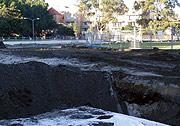Pitting our strengths in water
UNSW has built Sydney's largest percolation pit on its Kensington campus. The pit drains the storm water from 70 percent of the campus into the Botany aquifer.
UNSW has built Sydney's largest percolation pit on its Kensington campus. The pit drains the storm water from 70 percent of the campus into the Botany aquifer.

UNSW has built Sydney's largest percolation pit on its Kensington campus. The pit drains the storm water from 70 percent of the campus into the Botany aquifer, which lies beneath the University.
As well as replenishing the aquifer, which is used as an additional water supply by local residents and industry, the pit takes some pressure off Kensington's storm water pipes by channelling the water into the aquifer rather than the sewage system.
Paul Osmond, head of the UNSW Environment Unit said, "We put the pit in late last year as part of the largest redevelopment of the campus in 30 years. The pit is one of those all too rare wins all around, for the environment, for the University's bottom line and from a sustainability and infrastructure perspective."
The pit's chamber, which is under the University oval, is approximately 10 metres wide, 1.6 metres deep and half the oval's circumference. A milk-crate-like structure has been used to create an empty space where rainwater is collected. The water is then allowed to seep slowly through the sandy soil and into the aquifer.
In a year of normal rain the pit would return 160 megalitres of storm water to the aquifer. That is 80 per cent of the total water that UNSW takes out of the aquifer for irrigation and other non-potable uses on campus.
Returning water to the top of the aquifer pushes the pollutants from the Botany industrial area back down the aquifer to areas where companies are able to decontaminate them.